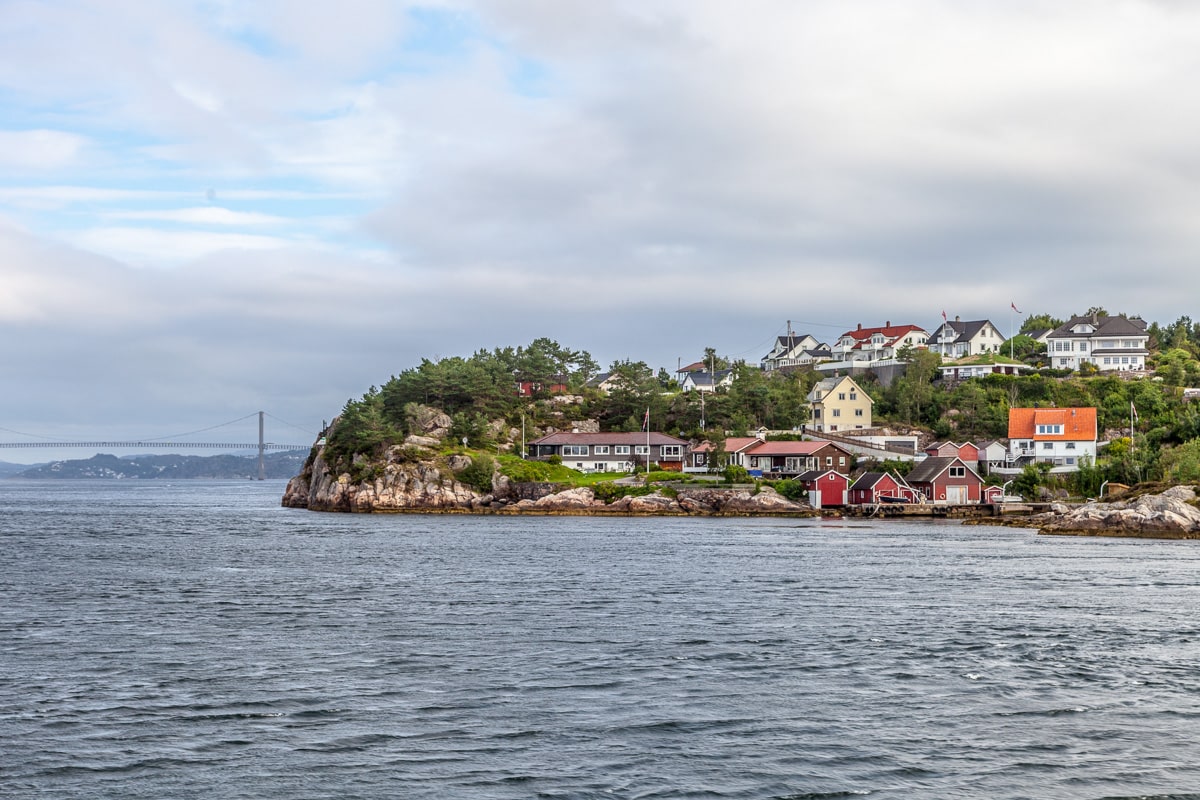 After a few days back in Bergen with its approximately 240 days of precipitation a year, we were ready to get away again. Previous excursions had been to the north, so this time we decided to look south.
After a few days back in Bergen with its approximately 240 days of precipitation a year, we were ready to get away again. Previous excursions had been to the north, so this time we decided to look south.
Our search turned up the small village of Rosendal located on the Hardangerfjord, the fourth longest fjord in the world, and the second longest fjord in Norway.
 Looking at the transportation options, the ferry was our only real option, given how far the fjords extend in from the coast. Visiting many parts of Norway are simply much easier and cheaper using the ferry system as opposed to renting a car and driving.
Looking at the transportation options, the ferry was our only real option, given how far the fjords extend in from the coast. Visiting many parts of Norway are simply much easier and cheaper using the ferry system as opposed to renting a car and driving.
As an example, for this trip, car rental for two full days would be about $200, petrol (gasoline) at $6.50-$9.25 per gallon and 120+ miles RT (about 2.5-3 hours driving time) would cost about $35. Then adding the ferry crossing for the car and two passengers would take about $50 RT. So the total transportation cost by car would be just under $300. On the other hand, the round-trip ferry voyage including a tour and lunch at Baroniet Rosendal was about $180 for two, would take about two-hours, and someone else drove.
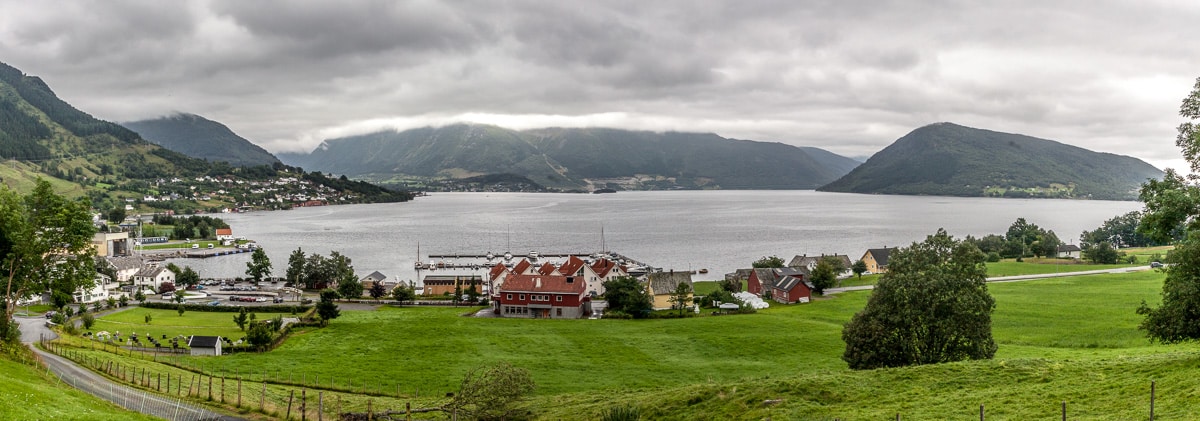 Rosendal is a beautiful little village on the Hardangerfjord and the trip to get there again took us through the skerries that occupy the Norwegian coast.
Rosendal is a beautiful little village on the Hardangerfjord and the trip to get there again took us through the skerries that occupy the Norwegian coast.
A skerry is a small rocky island, generally too small for habitation; it may simply be a rocky reef or a small sea stack. Norway’s island fringe consists of thousands of these islands. Glacially formed, skerries are the result of ancient cross-fjords that parallel the coast providing a protected channel behind an almost unbroken succession of skerries and mountainous islands.
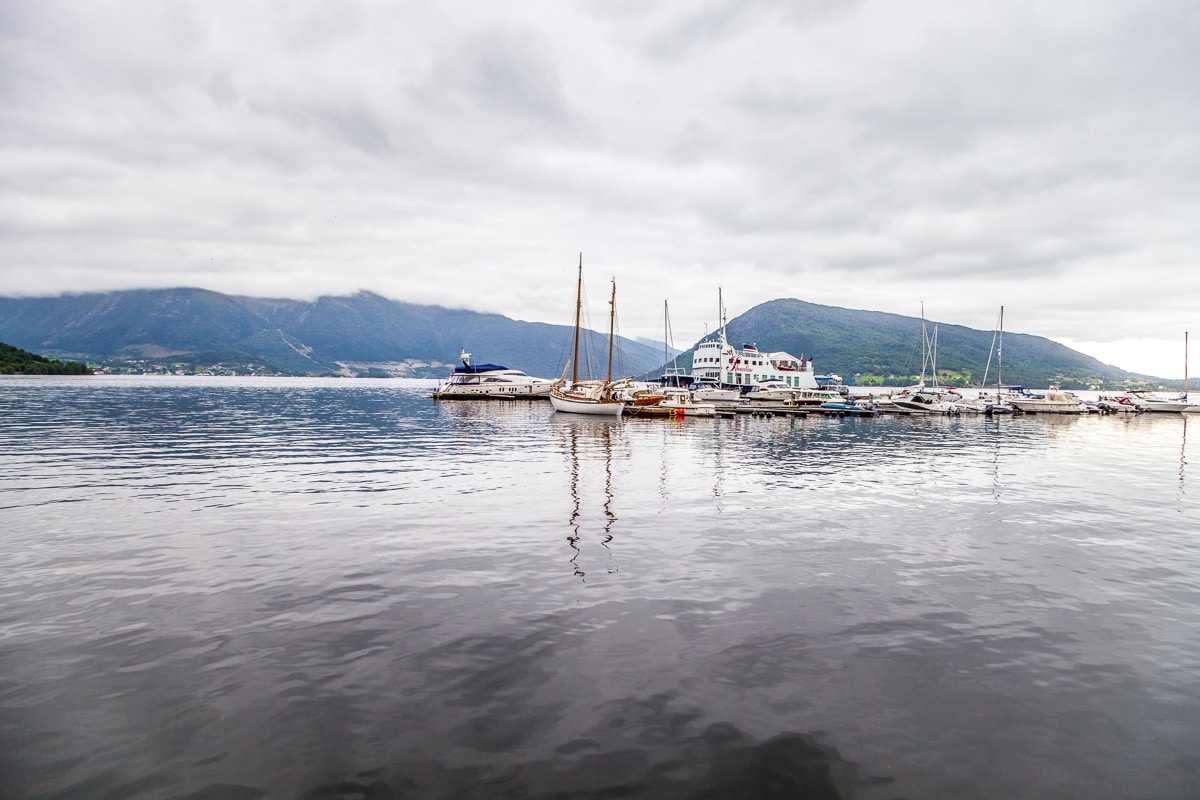 Our boat threaded the skerries and made way up the Hardangerfjord, where we disembarked at the wharf in Rosendal. We then quickly found our way to the small tourist information office where we got a map and information on what to do in this tiny Nowegian village (pop. <800).
Our boat threaded the skerries and made way up the Hardangerfjord, where we disembarked at the wharf in Rosendal. We then quickly found our way to the small tourist information office where we got a map and information on what to do in this tiny Nowegian village (pop. <800).
The half-mile walk to our hotel, the Rosendal Fjordhotel pretty much took us from one end of town to the other. We checked in to our room, and after admiring the fabulous view we made our way to the 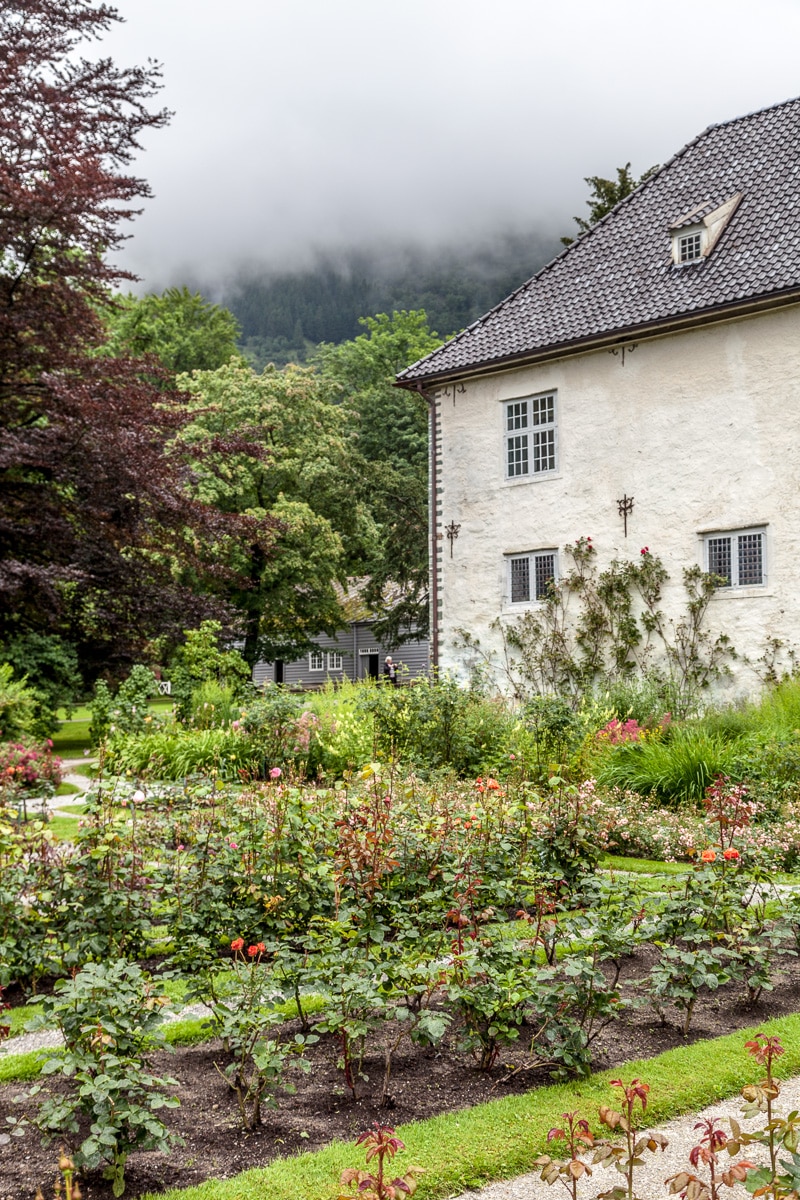 Baroniet Rosendal, a famous historic estate and manor house from the 1650s where we had delicious lunch of local products (included with our ferry package). After a very interesting tour of the manor house and the beautiful flower and vegetable gardens laid out around the manor, we ambled along the tree-lined lane back toward town.
Baroniet Rosendal, a famous historic estate and manor house from the 1650s where we had delicious lunch of local products (included with our ferry package). After a very interesting tour of the manor house and the beautiful flower and vegetable gardens laid out around the manor, we ambled along the tree-lined lane back toward town.
 Along the way, we detoured to the Rosendal Steinparken a little open-air gallery that displays, along a path through the forest, an interesting collection of large stones from the Folgefonna region. Most have been sculpted and/or polished to show the region’s geological diversity.
Along the way, we detoured to the Rosendal Steinparken a little open-air gallery that displays, along a path through the forest, an interesting collection of large stones from the Folgefonna region. Most have been sculpted and/or polished to show the region’s geological diversity.
From the Steinparken, we wandered toward the Kvinnherad kyrkje. The white, stone church was built about 1250 AD. The young tour guide in the church, a college student intern, was glad to finally have someone to talk to, as we were the only visitors this day and late in the afternoon.
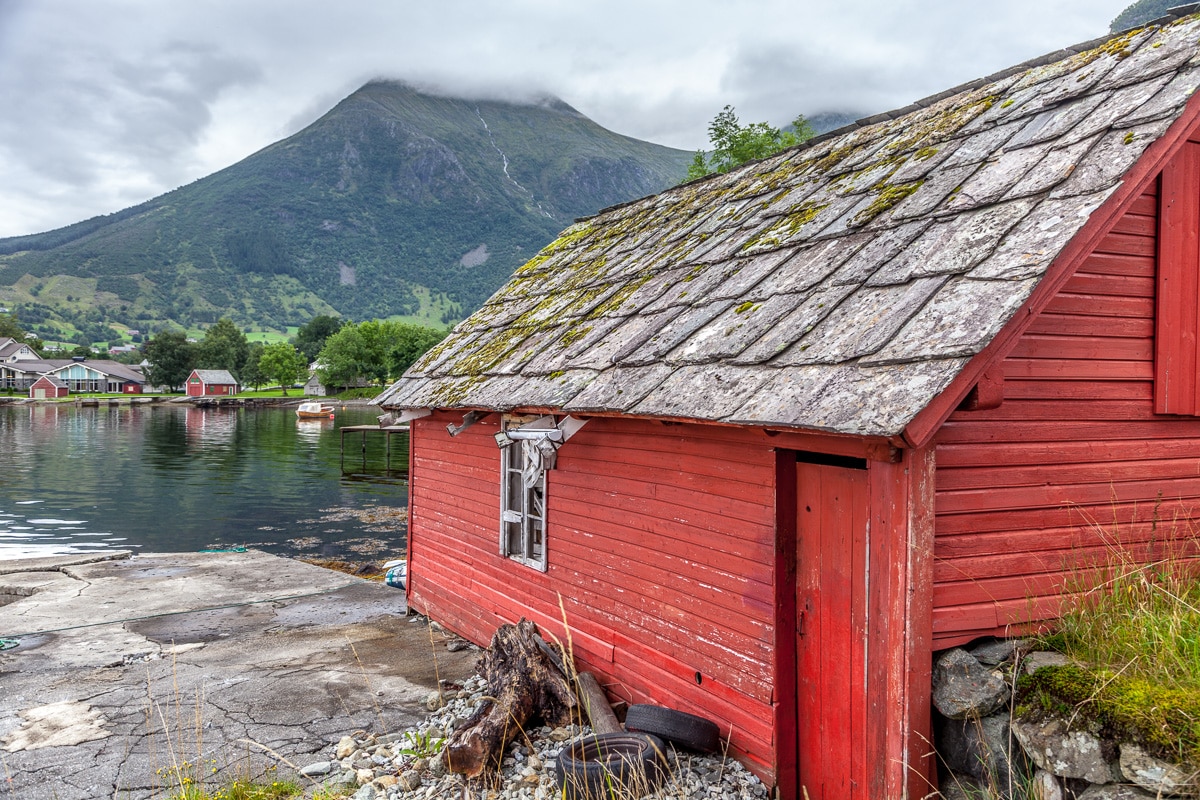 Finally returning to our hotel, we enjoyed a glass of wine on our small balcony overlooking the fjord with mountains in the distance. While Jeannie decided to stay and read a book, I took off to stroll along the shoreline for a bit before dinner.
Finally returning to our hotel, we enjoyed a glass of wine on our small balcony overlooking the fjord with mountains in the distance. While Jeannie decided to stay and read a book, I took off to stroll along the shoreline for a bit before dinner.
The cloudy weather wasn’t going away, but the temperature was pleasant and it wasn’t raining. The grey clouds added to the visual drama as I walked on the pebbled beach strewn with seaweed, while the boathouses and fishing shacks added color to the scenes.
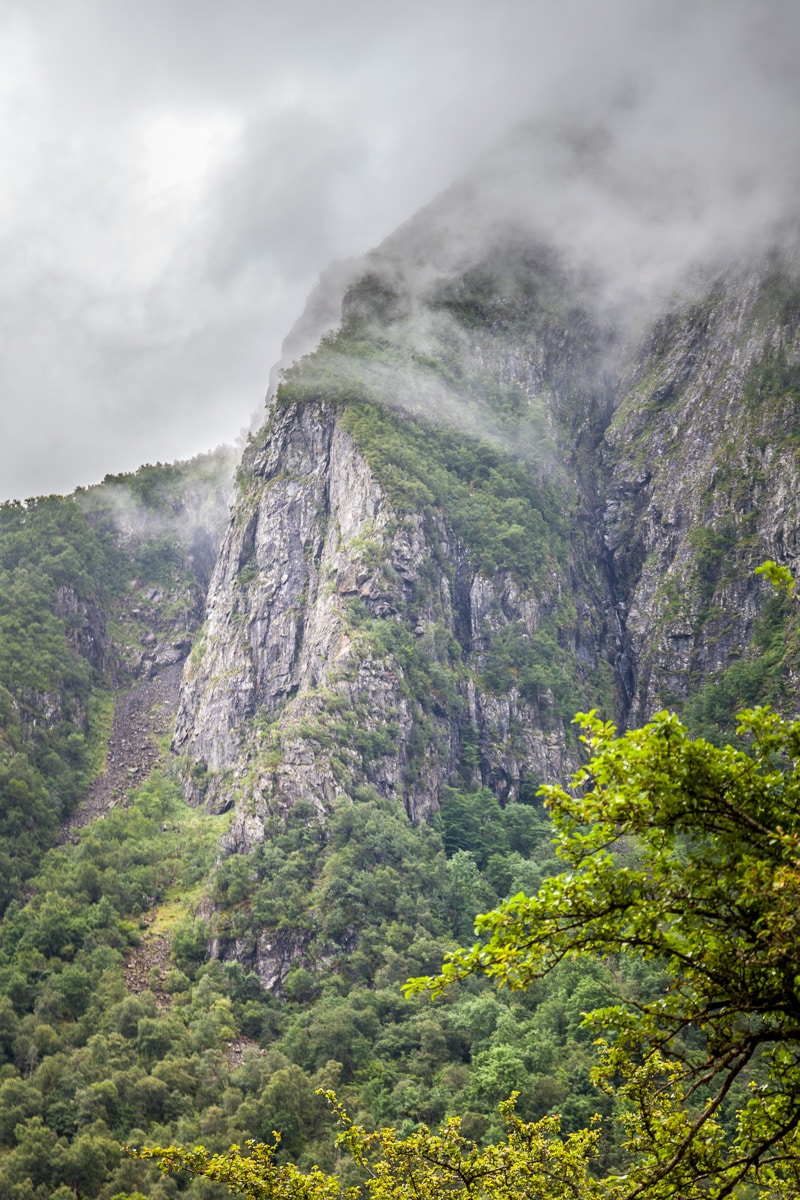 Hunger lured me back to the hotel where we had a wonderfully delicious dinner. Afterwards we returned to our room to watch the light of the day slowly die out behind the mountains across the fjord before turning in for a good night’s rest.
Hunger lured me back to the hotel where we had a wonderfully delicious dinner. Afterwards we returned to our room to watch the light of the day slowly die out behind the mountains across the fjord before turning in for a good night’s rest.
The next day we took off after breakfast to hike up to the Hattebergfossen, a beautiful set of falls that descend from the mountains and glacier of the Folgefonna national park. The trail started off gently then got progressively steeper. Though it is generally an easy climb, the recent rains made the footing muddy, slippery and somewhat treacherous. Fortunately it wasn’t raining as we viewed the powerful falls. The path passed through deeper mud as we approached the footbridge that crossed the turbulent waters of the river.
 As we walked the small road back towards the town, the rain began. Starting as light drizzle, it quickly increased to a steady downpour. Fortunately, we were prepared with our raingear. After a pleasant, though wet, walk to the cafe at the Baroniet Rosendal we stopped for a cup of tea and a bite to eat.
As we walked the small road back towards the town, the rain began. Starting as light drizzle, it quickly increased to a steady downpour. Fortunately, we were prepared with our raingear. After a pleasant, though wet, walk to the cafe at the Baroniet Rosendal we stopped for a cup of tea and a bite to eat.
The rains stopped just as we finished our tea, and we strolled back through the gardens of the Barony one last time before returning to the hotel to check out and head to the harbor. The ride back to Bergen, though grey was beautiful, and got us on the dock by about 1830 (6:30 pm). After a light, home-cooked dinner we fell into bed and a deep, well deserved sleep.










































































Dan Olson
18 Dec 2016Visited Rosendal 2 years ago. Was a beautiful area. Folks & Family were so helpful & friendly.
Can’t thank them enough. All have great holidays
Pat Grunder
15 Dec 2016This spot is ‘on the list’. Just beautiful. And, as always, the photos make your observations come alive!
Linda
14 Dec 2016Great pictures capturing some awesome scenery. Very impressive paintings on the buildings.
Debbie Clifton
14 Dec 2016Just beautiful! Your pictures are wonderful.
Missy Ortega
14 Dec 2016Travel on the ferry sounds a lot more fun than by car. Thank you for sharing another delicious journey !
cathi
14 Dec 2016I can only imagine a rainy night in Norway. Brrr.
The range of green in your photos is amazing.
Alice Mathias
14 Dec 2016Thanks !
Bruce Martin
14 Dec 2016I loved the photos & travelogue as I become more of an armchair adventurer.